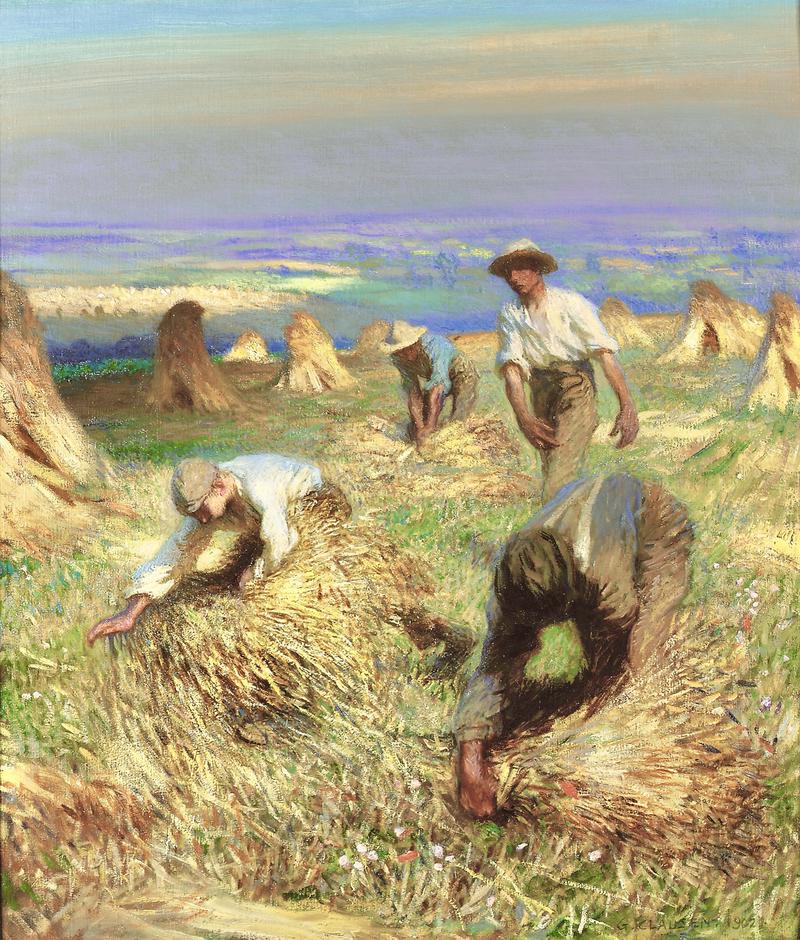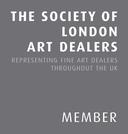Harvest, Tying the Sheaves

Exhibition
Manchester, City Art Gallery, Exhibition of Modern Paintings, Drawings and Prints, 1910, no. 88Pennsylvania, Pittsburgh, Carnegie Institute, no. 97 (not traced)
Ottawa, National Gallery of Canada, Exhibition of Contemporary British Paintings, 1915, no. 23
Sir George Clausen was an English artist of great longevity who held a position of huge importance in British art at the turn of the century. His art merges the worlds of natural realism and British Impressionism and provides a survey of predominantly rural pre- and post-World War I life in England. Over the course of his career, he developed a more fluid style, portraying movement and the play of sunlight and shade with flickering brushstrokes. Hussey wrote in his book, George Clausen (London, 1923): his work was ‘concerned with the life of the country labourer, his actions and the land he worked on … a literal truth raised to a higher power by his sense of design and his lyrical feeling for the beauty of light.’
During the final quarter of the nineteenth century, conditions in the English countryside preoccupied writers and artists. With imperial expansion, the rapid growth of cities and the ready availability of cheap foodstuffs from North America, agricultural production was in decline. Britain, which led the world in industrial mechanization, was slow to modernize its farming processes. Alongside the continued reliance upon labour intensive methods, an impressive rear-guard action was mounted by Edwardian intellectuals who sought to justify healthy outdoor work, in contrast to that of the factory. The countryside embodied healthiness and the city, degeneracy. George Clausen was central to this cultural movement, and within his work, the groups of pictures of field work, rick-building and grain-sifting, painted around 1900, are its pictorial archetypes.
The fact that the labourers are few in number in the painting reminds us that the period of large itinerant gangs had passed, and that by 1900, harvesting depended upon smaller groups based upon old tithed families. Boys and men and (young and old) would work together. The landscape itself is more than simply a backdrop against which Clausen’s figures perform: they progress through it, defining their spatial relationships as they move. The painter was preoccupied with movement, as his sketchbooks of the period indicate. Clausen accentuates the rhythmic, co-ordinated activity of the group by emphasising the movement of hands and forearms. There are no tools for this task. Two foreground labourers, working interdependently, one dramatically foreshortened, are bent over their work, gathering the final sheaves at the edge of the field, here indicated by a patch of rough soil and some wild meadow flowers at the bottom edge of the canvas. Once collected and tied, the sheaves are stacked upright in groups of five or six, in a stook. Dots of colour in the middle distance, indicate that this same activity is going on in a far-off field, while the striding harvester on the right, with his swinging arms and massive hands, provides an almost symbolic presence in what must be considered one of the most expressive of Clausen’s works. The swinging arms and long stride of the labourer pay a direct tribute to Millet’s The Sower (1850, Boston Museum of Fine Arts). The rhythm of movement is akin to the visual rhythm of the hayricks as they stretch out into the landscape; the shapes of the workers’ hats and the shapes of the hayricks mimic each other. It is as if the labourers are at one with each other and their work and at one with the rhythm of the seasons and the earth.
As with the Impressionists, Clausen was preoccupied with the concept of an ‘envelope’ of coherent atmosphere in which figures, foreground, middle distance and background are all seen together and partake of the same palette. The colours and textures of the faces, figures and clothing and the surrounding meadow are evenly weighted and like the Impressionists, Clausen permits the eye to bring separate touches of bright colour together. In a palette reminiscent of Van Gogh’s gleaners and harvesters, after Millet, the brilliant blues, mauves, ochres and whites reverberate throughout the canvas.



